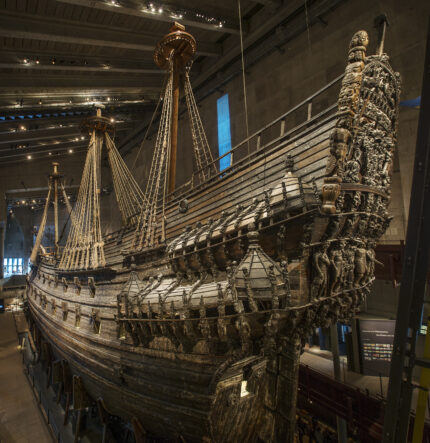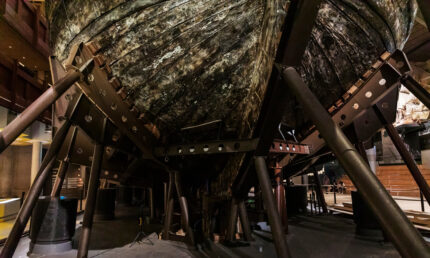 The Swedish royal warship Vasa, meant to be the flagship of King Gustav II Adolf’s new powerful naval fleet, sank 400 from the dock in Stockholm bay on its maiden voyage in 1628. It was raised from the sea bed in 1961, preserved by the cold waters in eerily good condition. It was conserved for 27 years at the Wasa Shipyard before moving into its permanent home at the custom-built Vasa Museum in 1988. It has been one of Sweden’s top tourist destinations ever since, drawing upwards of one million visitors a year.
The Swedish royal warship Vasa, meant to be the flagship of King Gustav II Adolf’s new powerful naval fleet, sank 400 from the dock in Stockholm bay on its maiden voyage in 1628. It was raised from the sea bed in 1961, preserved by the cold waters in eerily good condition. It was conserved for 27 years at the Wasa Shipyard before moving into its permanent home at the custom-built Vasa Museum in 1988. It has been one of Sweden’s top tourist destinations ever since, drawing upwards of one million visitors a year.
Now, 395 years after it went down the first time, Vasa is sinking again. The steel shoring struts that have been supporting it since 1964 are insufficient to bear the ship’s great weight, and worse than that, the cradle is putting pressure on the fragile timbers, cracking and warping them. Vasa is continuously being monitored and measured to detect any potential conservation issues, and the data show it is sinking downwards and outwards at a very slow, but very steady rate of a millimeter a year. As gradual as the shifting is, if uninterrupted, the ship will start falling apart.
The Vasa Museum has undertaken a wide-ranging investigation to discover what kind of pressures Vasa‘s wooden structure can stand, teaming with researchers from Uppsala University, the Swedish University of Agricultural Sciences, the KTH Royal Institute of Technology and other institutions. They have identified several decomposition processes that are causing the wood to deteriorate much more rapidly than it did in the cold, brackish waters of the Baltic. The current strength of the ship’s timbers is no more than 40% the level of normal oak.
 In such a weakened state, the timbers are simply incapable of bearing the weight of the rebuilt ship. To address this fatal structural instability, the Vasa Museum team is going back to the drawing board, redesigning the support structure starting with a new internal support system that will rest on a new external support. The internal structure will be a framework of pipes that will unobtrusively add load-bearing strength and lock the ship into shape, preventing that constant movement downwards and outwards. The external supports will be streamlined and strengthened and then connected to the internal support network.
In such a weakened state, the timbers are simply incapable of bearing the weight of the rebuilt ship. To address this fatal structural instability, the Vasa Museum team is going back to the drawing board, redesigning the support structure starting with a new internal support system that will rest on a new external support. The internal structure will be a framework of pipes that will unobtrusively add load-bearing strength and lock the ship into shape, preventing that constant movement downwards and outwards. The external supports will be streamlined and strengthened and then connected to the internal support network.
This is an absolutely huge project and unfortunately it cannot be accomplished without making changes to the ship itself. Parts of the interior will have to be removed and placed in storage to make way for the new internal structure. New holes will have to be drilled into the hull. Even the floor underneath it will need to be reinforced.
“It’s a big job,” said [project director Magnus] Olofsson. “We have already been researching for four years to see how we are going to do it, and then we’ve been working on construction drawings for four years and now we are beginning the build, which will also take about four years.”
They have being carrying out test operations on full-scale models to make sure their plan will work. They do not, however, know exactly how much the vessel weighs. They estimate between 900 and 1,000 tonnes.
But the project is coming at a substantial cost, which the self-funded museum is appealing to donors and sponsors to finance. The museum’s director, Jenny Lind, said she was hopeful the Swedish public would come through to raise the funds to embark on the ship’s “biggest challenge” since its salvage and conservation.
“When Vasa was salvaged, the whole of Swedish society came together and made it possible to salvage this ship. It wasn’t just the state, it was private companies, big actors in society that helped out, but also private individuals,” she said. “So that’s why we’re coming out again and saying we need help again.”
Right now the Vasa Museum is not set up for easy online donations, just bank transfers (information here) and contributions via the Swish app (info here).